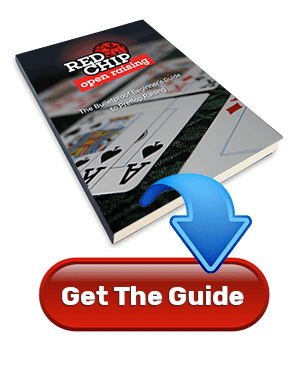
Here are some general guidelines:
- Since the blinds are your only monetary incentive to play hands, your primary pre-flop goal is to steal the blinds. Players may try to impede your progress by calling or raising. Think of them as implications in a potential secondary mission. Just remember that your primary goal is to steal the blinds.
- If it’s profitable to limp with a hand pre-flop, it’s generally more profitable to raise in order to put pressure on the blinds. Think of pre-flop poker as a pie chart. If you limp on the button with JsTs and the big blind gets to see the flop for free with A♥2♣, he will win the pot roughly 51% of the time. The amount of the time that he will win the pot is called his equity. If you force him to fold pre-flop, you effectively force him to surrender his equity and allow you to win all of the pie chart or, in this case, the pot.
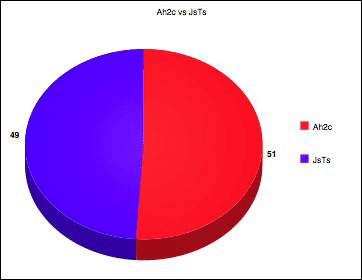
- To prevent astute opponents from gaining information about the strength of your hole cards, you should generally open to the same size. If you are playing against players that call too much and don’t pay attention to your raise sizes, you should raise as big as you can with value hands. If you are playing against players that fold too much and don’t pay attention to your raise sizes, you should min-raise with all of your weaker hands.
- To get the most folds for the least amount of money you should generally raise to three times the big blind. Game dynamics changes the fold equity relative to the ratio of big blinds risked. Many times, people won’t even consider folding unless you raise to four big blinds. Other times, a min-raise can be most effective.
- If people limp in front of you, it will take a bigger raise to get them to fold so you should generally isolate to a size that is three big blinds plus one big blind per limper. Again, the sizing changes based on game dynamics. The theory remains the same. Raise to a size where you are getting the most folds for your money. Don’t get frustrated if people call. I will teach you how to beat them post-flop. Just remember that you either want to buy your opponent’s equity or increase the size of the pot with the best hand.
So now that we’ve established that you should raise instead of limping pre-flop, naturally you’d like to know which hands you should raise. As I said earlier, your hand selection will be heavily influenced by your position.
Your position determines how much information you will have during the hand. When you are under-the-gun you have to act before seeing what anyone does. This is a huge disadvantage if your goal is to steal the blinds. As a result, you must play much more conservatively from early position.
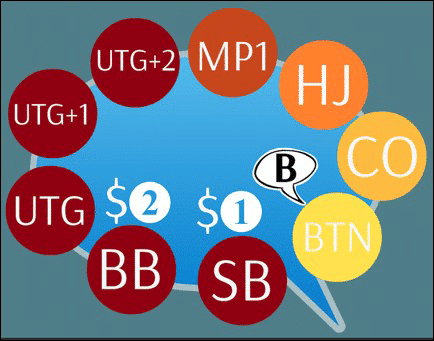
It’s impossible to say exactly how many hands you should play from each position because the percentage changes based on the type of game you are in. Remember that there can be up to nine other players that have a say in what happens after you raise. Conversely, if it folds around to you on the button, you have a huge advantage because you know that there are only two players left to prevent you from stealing the blinds. You can raise many more hands, especially if you know how the blinds will react to your raises. So how do we choose a default range of hands to play from each position?
A default range is what we will use without information on our opponents. Let me save you a lot of time and give you some ranges of hands that have proven to be profitable for me over a large sample size. I didn’t create these ranges. Database analysis experts have analyzed millions of hands played by solid professionals and determined which ones should have a long-term positive expectation. The following default ranges are how I interpret their research. Don’t get caught up in trying to find exact pre-flop ranges. There are a lot of hands that will only be slightly profitable on the fringes of a range.
80% of your profits will come from 20% of the hands you play. As a result, you should never be afraid to return to a tighter range if my suggestions are putting you in post-flop situations that are making you uncomfortable. As you improve post-flop, your pre-flop options will increase. Moreover, solid pre-flop decisions lead to better post-flop decisions. Keep in mind that this article is like a pre-flop playbook. Each individual hand is a player and your team of hands is a range. Each hand plays a role in getting your opponent to react differently to your range.
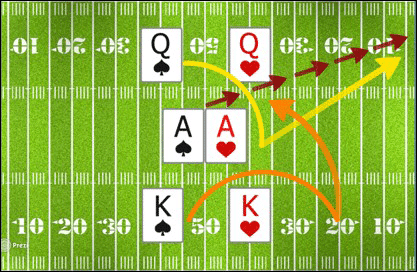
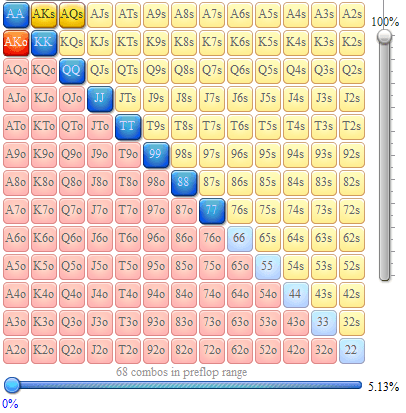
UTG
77+/AQs+/AKo
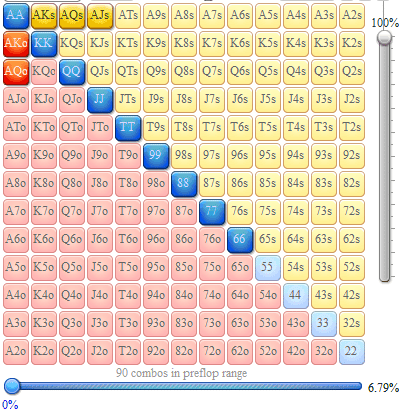
UTG+1
66+/AJs+/AQo+
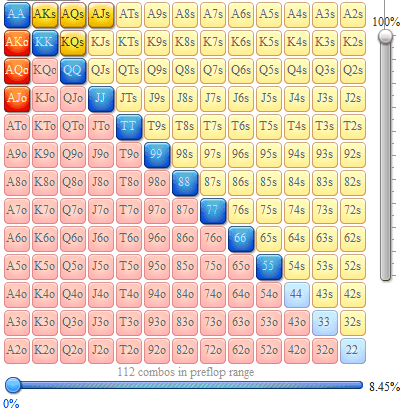
UTG+2
55+/AJs+/AQo+/KQs
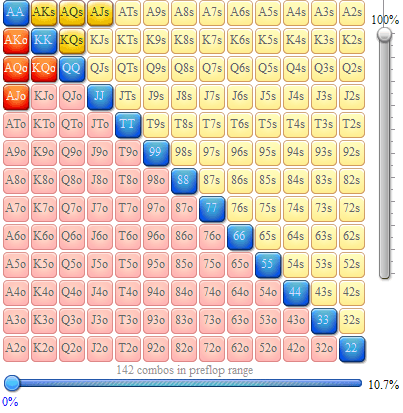
Passive Table Range (UTG-UTG+2)
22+/AJ+/KQ
I use this range in passive $2/$5 games against opponents that don’t 3-bet enough. I raise all of the pockets pairs because the hands generally go multi-way and I feel that my opponents will make poor decisions when I flop a set. This range is much harder to use against opponents that will adjust by 3-betting you more often because there are too many weak hands in it to have a balanced 4-betting range.
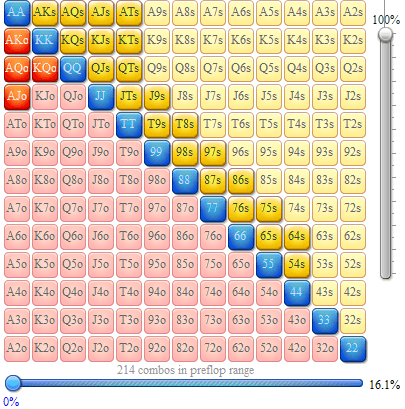
Passive Deep Table Range (UTG-UTG+2)
22+/ATs+/AJo+/KTs+/KQ/54s+/64s+
I use this range in very passive games with very deep stacks. If my opponents adjust by 3-betting more often I will revert to a tighter range. When I use this range I am hoping that nitty players will 3-bet me with a face-up range allowing me to flat and utilize implied odds when stacks are very deep.
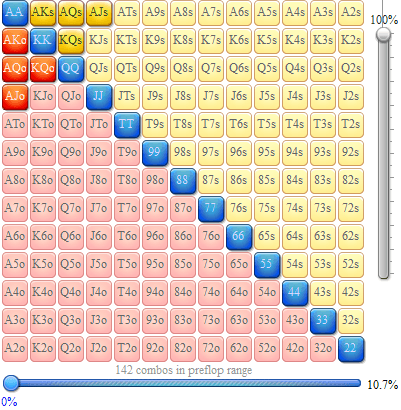
MP
22+/AJ+/KQ
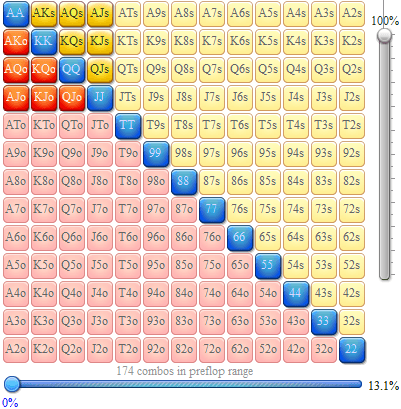
HJ
22+/AJ+/KJ+/QJ
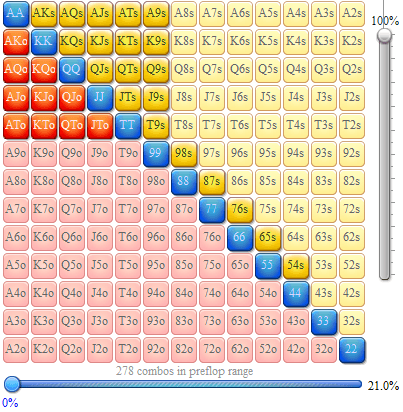
CO
22+/ATB/A9s/K9s/Q9s/J9s/54s+
*ATB = Any Two Broadway cards
If the button is a very tight player I will raise a button range from the CO because I don’t expect the button to interfere with my blind stealing attempt. If the button is a very loose-aggressive opponent that 3-bets too much I will often raise with the intention of 4-betting no matter what. If he adjusts by 5-betting me I will revert back to the default range because it has a higher percentage of good hands that can defend against the button’s 3-bets.
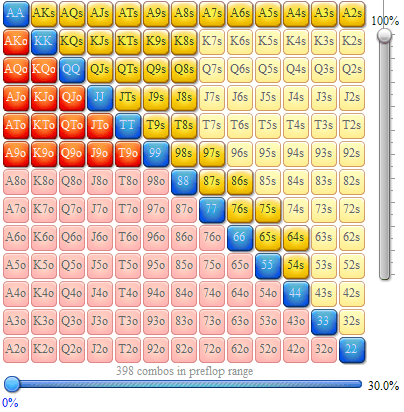
Button Default Range
22+/ATB/A2s+/K8s/Q8s/J8s/A9o/K9o/Q9o/J9o/T9o/54s+/64s+
Keep in mind that if you can steal the blinds more than 2/3 of the time, you are making an instant profit. You could literally open any two cards from the button. You would be risking 3bbs to win 1.5bbs. You’re laying 2:1 odds so you only need them both to fold 2/3rds of the time. That’s ignoring the times you out-flop them! I have played in many games where the blinds were really that tight. Do I adjust by raising any two cards? Usually not. Why? I don’t want to raise so often that I force the blinds to adjust. I raise until I begin to see resistance. I want my opponents to stay predictable because predictable opponents are easy to beat.
Instead, I might use a range like this:
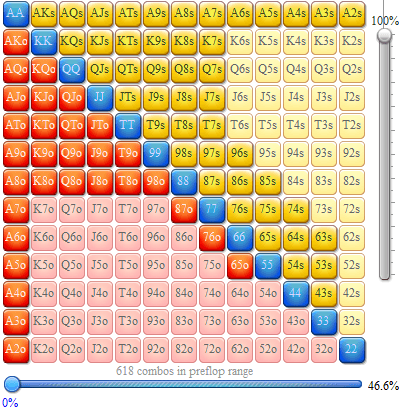
Button vs Tight Blinds Range
Another thing you can try is min-raising when the blinds play too tight. This gives you an even better price on the steal. Also, what if your opponents call way too much and fold the flop unless they hit something big? Then you use a range like this with a much bigger size. Raise to 4-5bbs with the intention of c-betting most flops. Players that defend too loosely are even easier to beat than players that are too tight. They play so many garbage hands that they rarely flop something strong. As a result, you can apply a lot of pressure to them post-flop and force them to fold weak pairs and draws.
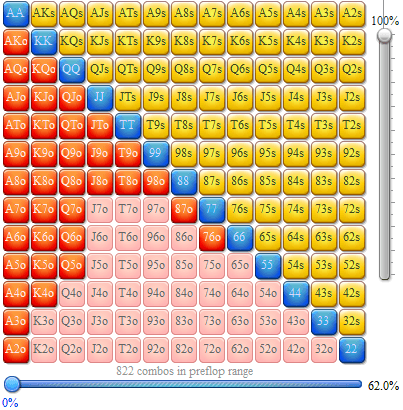
Small Blind Default Range
22+/AT8+/ATS/A2+/K4+/Q5+/76+
*AT8+ stands for Any Two cards Eight or better *ATS stands for Any Two Suited cards
Again, remember that you can raise any two cards if your opponent is folding way too much. If your opponent is very good post-flop and he rarely folds pre-flop you should try raising to 4bb’s instead of 3bb’s. This will usually do the trick by ending the hand early. If your opponent still doesn’t back down, it’s okay to use a tighter range if you don’t think you can compete with him post-flop. Also, never adjust by limp-calling against a good player. A good player will raise you a large percentage of the time and use his position to abuse you.
Unless you are intending to limp-raise, you should rarely be limping against a solid player; however, limping is a great option against loose-passive players. They won’t raise you in position, you keep the pot small, and you give yourself a chance to evaluate the flop. One more thing, I know I said that you shouldn’t adjust by raising every single hand when your opponent is playing too tight. There is an exception – tournaments. In a tournament setting, you usually don’t have to worry about your opponent having enough time to gather info on you to adjust. Attack mercilessly and build a big stack so you can go deep.
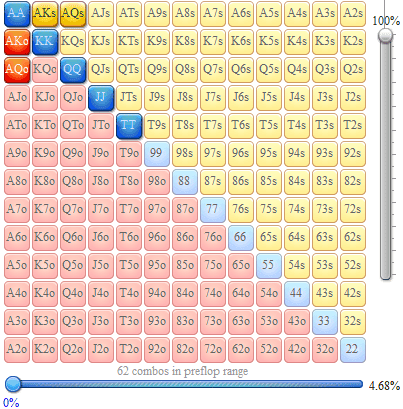
Big Blind Default Range
If you have an opportunity to raise from the big blind, it’s because it limped around. If multiple people limped I would suggest sticking to a tighter raising range. Most people don’t limp with the intention of folding. Still, others limp with the intention of raising. Obviously, it’s situational. If just the small blind limps, I frequently raise any two cards. If the button and the small blind limp, my decision is based on how sticky the button will play post-flop. If he will play very fit-or-fold, I will attack from the big blind with a wide range of hands. But in general, I stick to a tight range from the big blind. I raise to 5-12 big blinds based on how many opponents are in the hand, their stack sizes, and how I think they’ll react. One more thing, it’s generally a huge leak to raise with a pocket pair smaller than tens. You will be out of position and you’ll have to deal with overcards about half the time. Just check and take the free flop!
So to recap, I’d say these simple adjustments alone will usually be enough to turn a breakeven player into a +5 BB/100 winner. That’s without considering the changes I can help you make in your isolation ranges, flatting ranges, blind defense ranges, 3-bettting ranges, and the other less common pre-flop situations. Remember, this is all in order to create profitable post-flop situations for yourself. A solid pre-flop strategy carries over to your post-flop game because you’ll have fewer structural imbalances in your c-betting and barreling ranges. So if you feel that you’ve gained from this article, make sure that you watch my videos here and on my new site CheckShovePoker.com. Anyway, make sure that you run good, have fun, and constantly look for ways to improve.
Mobile users: Click here to sign up and receive your free guide.

Hi Hunter,
Cheers for a great article – excellent stuff for a player like me who still struggles with those sinful temptations to play hands that look good but are actually poison fruit 🙂
Just a practical question about the CheckShovePoker site – although I can access the main menu page ok, as soon as I try to click on any of the thumbnails for strategy etc my virus software (Avast) kicks in and says that it’s unsafe. Is is just being over sensitive or are there any problems at the moment?
Either way, hope to check it out sometime!
All the best,
Charlie
Thanks Charlie, I’ve had a few people say that. You’re antivirus software is too sensitive at the moment. I’m working to create universally recognizable links for my site. I hope that didn’t deter you from checking out my products. Thanks.
Hi, just a general question – are these opening ranges generally for full ring, or can be used in 6-max to some extent?
Mathematically, 6 max is like full ring where the first few people have folded. In practice though six max is much more aggressive because of the people that are attracted to it.
Mathematically, it is not. In a vacuum, your EV is the same (although, not really given the Villain’s range should change); HOWEVER, it changes the Nash Equilibrium by giving you 3 more spots (in 9-handed) to steal the blinds, and therefore, you should play tighter open-raising range from the CO in 9-Max than in 6-Max if you are playing GTO.
Your Small blind range should be significantly tighter than your BTN range.
Why is your Small Blind Default Range so Huge
When it folds to you in the SB, there is only one person between you and picking up the blinds. Fight hard!
Quick question about the ranges in this article: the UTG+2 default image shows AJo as an open raise, but the notion below says UTG+2 should be only AQo+. Is the UTG+2 image incorrect? I’m assuming AJo is not +EV as a pure default at UTG+2 in a full ring table.
Nice post, you don’t use PASSIVE DEEP TABLE RANGE (UTG-UTG+2) in MP-CO positions too ?
What do people think about the bet sizing in this article? If this is live-focused I have never played at a table where a 3x will get significant folds. I’d say 5x-6x is about where people start taking notice live. Of course, I’m sure this is hugely game dependant, but 3-4x feels a bit online.
My opening ranges are much wider than this.
what do the colors mean?
Which colors?